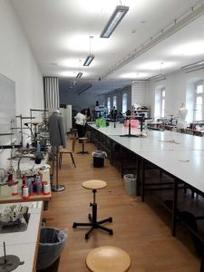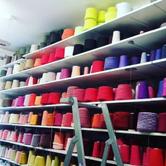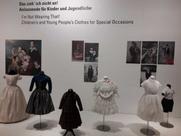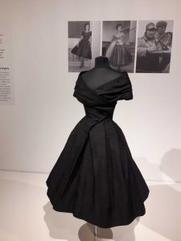What clothes (could) tell

On May 18, 2019 I participated in my very first #InstaWalk. This was also a premiere for the The city museum Simeonstift in Trier, they tried this format for the first time.The current special exhibition "Appropriate clothing is requested - fashion for special occasions from 1770 until today" was a successful choice. Beautiful and exciting occasional clothing from around 250 years, from christening robes to mourning clothes, from ball gowns to emergency clothing from wartime - they are a real feast for the eyes. Most of the dresses presented come from the private collection of Ralf Schmitt, who is also part of the exhibition's curator duo. More on this later.
In the fashion class
The #InstaWalk first led us to the University of Applied Sciences in Trier, to the studios of the department of fashion design. There, Ralf Schmitt, who is also teaching there, welcomed us. We gained exciting insights into a place where fashion design has been taught continuously since the founding of the fashion class of the School of Art and Design in Trier in 1922. A record at least in Germany, as we were able to learn.


On Instagram, Twitter, and Co, you can find most of the results of our visit to the fashion studios under #modestadt_trier. I deliberately say "most". Although the participants were informed in advance about the hashtags of the day #modestadt_Trier and of #photoMW and #MuseumWeek, it would have been good to give them to us again on the day itself. I would have liked name tags with the Instagram-, Twitter- and Co - names of the participants anyway, on which all other relevant hashtags and social media accounts of the museum and the faculty of fashion design and the University of Applied Sciences in Trier could have been indicated. During the InstaWalk, I had just enough to do with posting regularly without missing anything important. A search for important hashtags and institutions was hardly possible. Just as a small suggestion for the next time.
What a tour with passion can do
We then saw the exhibition together with members of the Museum's circle of friends during a preview tour by the two curators. I joined the group led by the collector Ralf Schmitt.

And what can I say? With his enthusiasm and love for every single dress, his great expertise both in the cultural history of dresses and in material and conservation aspects, as well as in design and creation, he made the tour a very special experience. Of course, the beautiful exhibition also contributed to this. Not only the special exhibits, but also the concept was very successful. In the run-up to the exhibition, the museum made an appeal to the public to send in photos or exhibits, to tell the stories about them, and thus become part of the exhibition. And this call was answered. And so very special exhibits came together. A wedding dress from a village in the Eifel, which was sewn from parachute balloon silk in the post-war period. An evening gown worn by a lady of the Trier society at the Salzburg Festival - together with photos of the occasion and, touchingly, a drawing of the dress made by her husband for the little niece who loved her aunt's clothes so much. Ralf Schmitt spoke stirringly about how he had been gathering the collection over many years, about the suffering of the collector, who renounces many things for his passion and is happy about every new piece.

Exciting details and still ongoing research questions (e.g. did the Dior dress on display really belong to Sophia Loren?) and workshop reports on the often difficult restoration and conservation work, the incredibly time-consuming work that is necessary to present historical clothing... all this and much more we learned that evening.

It's a beautiful and highly recommended exhibition, but...
The exhibition is recommendable. But please visit with a guide! This is my limitation, which is perhaps also to be understood as a question to the museum team. In the exhibition, texts were deliberately used sparingly. Printed station texts in two languages offer overview information. Object numbers are attached to the clothes. On the evening of the preview, however, no object texts could be found to which the numbers referred. Therefore, no information was available for the individual dresses. But maybe this was still handed in later?
But even if that was the case, my conclusion remains: this wonderful exhibition was only really enlivened by the captivating, guided tour by the collector. Hence the title of the blog post "What clothes (could) tell". Unfortunately, those who will visit the exhibition without a guided tour will not be able to enjoy the entire exhibition. The thrills will probably be missing.
In this case, a media guide would represent real added value. One could, for example, offer video recordings in which collectors tell about their exhibits in such a lively way (as he himself said during the guided tour "in chat mode"). Films or pictures of the restoration would be interesting, stories about the photos of Trier's citizens, who might be able to comment on them themselves. Furthermore, new findings (e.g. on the "Sofia Loren" dress?) could be added later. Maybe other Trier citizens will get in touch with us, who have interesting occasional fashion and pictures of it at home. They could then at least become a digital part of the exhibition.
Media guides, audio guides and co. do not always have to be. But I think this example shows very well how multimedia media can actually be an important and integral part of an exhibition, especially here, if there is no personal mediation. The, I cannot say it often enough, beautiful, and cleverly conceived exhibition would certainly gain even more from this.
all photos: B. Weber-Dellacroce, tuomi S.A.



